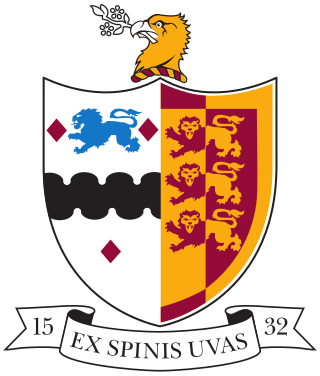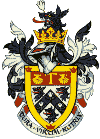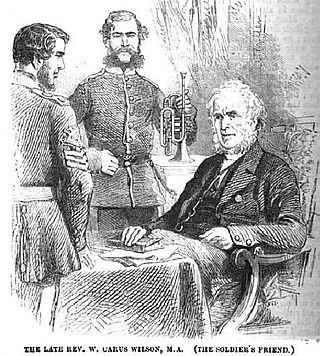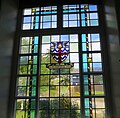
Cranbrook Schools is a private PK–12 college-preparatory school located on a 319-acre (129 ha) campus in Bloomfield Hills, Michigan. The schools comprise a co-educational elementary school, a middle school with separate schools for boys and girls, and a co-educational high school with boarding facilities. Cranbrook Schools is part of the Cranbrook Educational Community (CEC), which includes the Cranbrook Institute of Science, the Cranbrook Academy of Art, and Cranbrook House and Gardens. Christ Church Cranbrook is also on campus. The Cranbrook community was established by publishing mogul George Booth, who bought the site of today's Cranbrook community in 1904. Cranbrook was designated a National Historic Landmark on June 29, 1989 for its significant architecture and design. It attracts tourists from around the world. Approximately 40 acres (160,000 m2) of Cranbrook Schools' campus are gardens.

Bristol Grammar School (BGS) is a 4–18 mixed, private day school in Bristol, England. It was founded in 1532 by Royal Charter for the teaching of 'good manners and literature', endowed by wealthy Bristol merchants Robert and Nicholas Thorne. The school flourished in the early 20th century under headmaster Sir Cyril Norwood (1906–1916), embodying "the ideals and experiences of a leading public school". Norwood went on to serve as the master at Marlborough College and Harrow, and as president of St John's College, Oxford.

Bromsgrove School is a co-educational boarding and day school in the Worcestershire town of Bromsgrove, England. Founded in 1553, it is one of the oldest public schools in Britain, and one of the 14 founding members of the Headmasters' Conference.

Sedbergh School is a public school in the town of Sedbergh in Cumbria, in North West England. It comprises a junior school for pupils aged 4 to 13 and the main school for 13 to 18 year olds. It was established in 1525.

Rydal Penrhos School is a private day school in Colwyn Bay, North Wales. It is the only Methodist school in the independent sector in Wales. It is located on multiple sites around the town with a site in the neighbouring village of Rhos-on-Sea where it keeps its watersports equipment for easy access to the beach.

Windermere School is an independent, coeducational boarding and day school in the English Lake District. Founded in 1863, it has approximately 360 pupils between the ages of 3 and 18, around a third of whom are boarders. The School is split across three campuses on over fifty acres of land: the junior school at Elleray; the senior school and sixth form at Browhead; and Hodge Howe, the school's Royal Yachting Association watersports centre on the shores of Lake Windermere.

Taunton School is a co-educational independent school in the county town of Taunton in Somerset in South West England. It serves boarding and day-school pupils from the ages of 13 to 18.

St Catherine's School is a private Anglican Junior and Senior day and boarding school, located in Waverley, an eastern suburb of Sydney, New South Wales, Australia.
Lincoln Minster School is an independent co-educational day and boarding school in Lincoln, England.
St Martin's Ampleforth (SMA) was a private school and the preparatory school for Ampleforth College, which closed in July 2020. Until 2018 it was at Gilling Castle, North Yorkshire, England, on the southern side of a valley opposite the College on the northern side, in the Roman Catholic Diocese of Middlesbrough.

Cowan Bridge is a village in the English county of Lancashire.

Heath Mount School is a Church of England co-educational independent prep school near Watton-at-Stone, Hertfordshire, England. It admits pupils aged 3 to 13. It was founded as Heath Mount Academy in Hampstead in 1796. In 1934 it was relocated to a Georgian mansion on the Woodhall Estate in rural Hertfordshire. For the 2022 academic year, 498 students were enrolled: boarding pupils and day pupils and girls and boys.

Woodhouse Grove School is a private, co-educational, day and boarding public school and Sixth Form. it is located to the north of Apperley Bridge, West Yorkshire, England. The school, and its preparatory junior school, Brontë House, is located in the Aire Valley. There are approximately 1,000 students on roll, currently including around 90 boarders.

Casterton is a small village and civil parish close to Kirkby Lonsdale on the River Lune in the south east corner of Cumbria, England. In the 2001 census the parish had a population of 500, decreasing at the 2011 census to 425.

Rookwood School is an independent day and boarding school for children aged 2 to 18, located on a campus off Weyhill Road in Andover, Hampshire, England.

New Park School was an independent preparatory school in St Andrews, Fife, Scotland. The school was founded in 1933 by Cuthbert Dixon, previously a teacher at Merchiston Castle School.

Hereford Cathedral Junior School is an independent, co-educational day school for children aged from three to eleven years. The Junior School is part of the Hereford Cathedral Foundation and has been under the aegis of the governors of Hereford Cathedral School since 1987.

Cowan Bridge School refers to the Clergy Daughters' School, founded in the 1820s, located in Cowan Bridge in the English county of Lancashire. It was a school mainly for the daughters of middle class clergy and attended by the Brontë sisters. In the 1830s it moved to Casterton, a few miles away.
Lichfield Cathedral School is a private day school in the city of Lichfield, Staffordshire, England. It traces its lineage to the 14th century when Lichfield Cathedral made provisions to educate its choristers. The school in its current form now educates over 400 boys and girls from nursery to sixth form. While the school still serves its primary purpose of educating choristers of the cathedral, it is open to pupils of all faiths.

William Carus Wilson was an English churchman and the founder and editor of the long-lived monthly The Children's Friend. He was the inspiration for Mr Brocklehurst, the autocratic head of Lowood School, depicted by Charlotte Brontë in her 1847 novel Jane Eyre.






















